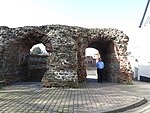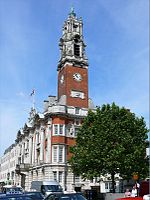Colchester Arts Centre

The Colchester Arts Centre, is an arts centre in Colchester, Essex, which is located in a former Church of England parish church, the church of Saint Mary-at-the-Walls, a name derived from its proximity to the Roman town walls. The church may have had Anglo-Saxon origins but was first mentioned in the early 13th century. The building was badly damaged during the English Civil War and was fully rebuilt twice in the 18th and 19th centuries, with the exception of the 16th century bell tower which has been heavily restored. The church became redundant in 1978 and opened as an arts centre in 1980. It hosts a wide variety of events, specialising in emerging talent, with a number of well known artists having made early appearances at the venue. It is a Grade II listed building.
Excerpt from the Wikipedia article Colchester Arts Centre (License: CC BY-SA 3.0, Authors, Images).Colchester Arts Centre
Church Street, Colchester
Geographical coordinates (GPS) Address Nearby Places Show on map
Geographical coordinates (GPS)
| Latitude | Longitude |
|---|---|
| N 51.888584 ° | E 0.89451 ° |
Address
Colchester Arts Centre
Church Street
CO1 1NF Colchester
England, United Kingdom
Open on Google Maps









